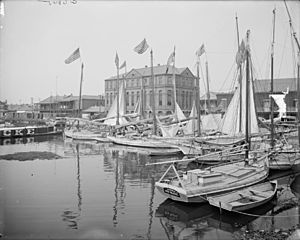Carondelet Canal facts for kids
The Carondelet Canal, also known as the Old Basin Canal, was a waterway in New Orleans, Louisiana, U.S.A. It was used for almost 135 years, from 1794 until the 1920s.
Contents
Building the Carondelet Canal
Work on the Carondelet Canal began in June 1794. It was ordered by Baron Carondelet, who was the Governor of Louisiana at the time. The canal was named after him. Many people worked hard to build the canal, including some who were made to work.
The canal was about 1.6 miles long. It started at Bayou St. John, which connected to Lake Pontchartrain. From there, it went inland towards the edge of New Orleans, behind the French Quarter in the Tremé neighborhood.
Early Years and Purpose
The first version of the canal was finished by the end of 1794. It was shallow and narrow. Over the next two years, workers made the canal wider and deeper. The Carondelet Canal officially opened in 1796. It had two main jobs:
- To help drain water from the city.
- To allow boats to transport goods.
However, when Governor Carondelet left Louisiana the next year, people stopped taking care of the canal.
Improvements and Importance
After the United States bought Louisiana in the Louisiana Purchase, James Pitot worked to make the canal better. Starting in 1805, a company called the Orleans Navigation Company improved both the canal and Bayou St. John. These improvements made the canal much more important for shipping goods.
The Turning Basin and Street Names
At the end of the canal, there was a large area where boats could turn around. This area was about 80,000-square-foot (7,400 m2). It was called a "turning basin." This basin inspired the name of Basin Street in New Orleans.
There were plans to build another canal from this turning basin all the way to the Mississippi River. However, this was a very difficult engineering challenge. The water levels of the river and the lake were different, so special Canal locks would have been needed. This connecting canal was never built. Still, the idea for it influenced the name of Canal Street in the city. A century later, the dream of a lake-to-river canal finally came true with the building of the Industrial Canal.
Competition and Decline
By the early 1820s, many boats used the Carondelet Canal every day. Reports said 70 to 80 vessels used it daily. In the early 1800s, the French-speaking part of New Orleans (the Creole section) competed with the English-speaking part (the uptown section). Business people from the uptown area built a competing waterway called the New Basin Canal in the 1830s.
The Old Basin Canal
By the time of the American Civil War, the New Basin Canal was much busier than the Carondelet Canal. The Carondelet Canal was often called the "Old Basin Canal" by then. In the late 1800s, larger ships became more common, and they were too big for the Carondelet Canal. Even so, the canal was still important for the economy into the early 1900s. It was especially important for boats that carried oysters.
Some early leaders of the Zulu Social Aid & Pleasure Club, a famous Mardi Gras group, used to arrive on the waters of the Old Basin Canal during their celebrations.
After World War I, fewer and fewer people used the canal. The City of New Orleans bought the canal in 1924. They started filling it in the next year.
Today, the area where the Carondelet Canal once flowed is now part of the Lafitte Greenway, a popular park and trail.
See also
 In Spanish: Canal Carondelet para niños
In Spanish: Canal Carondelet para niños



